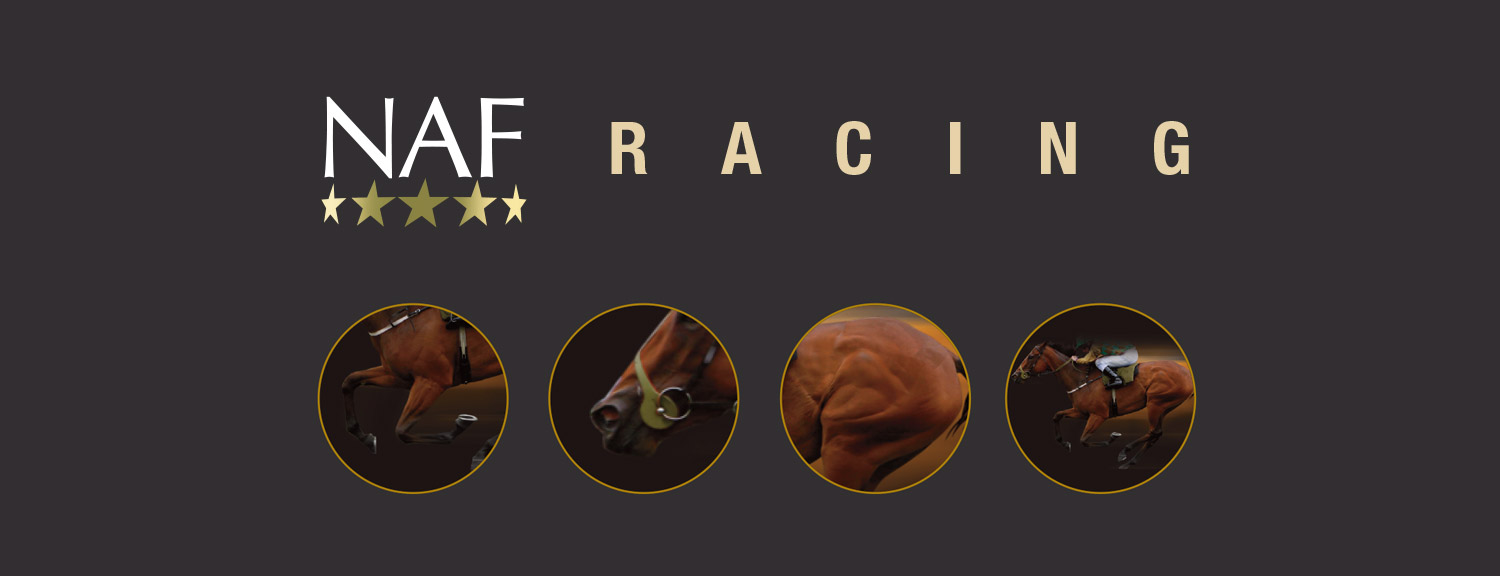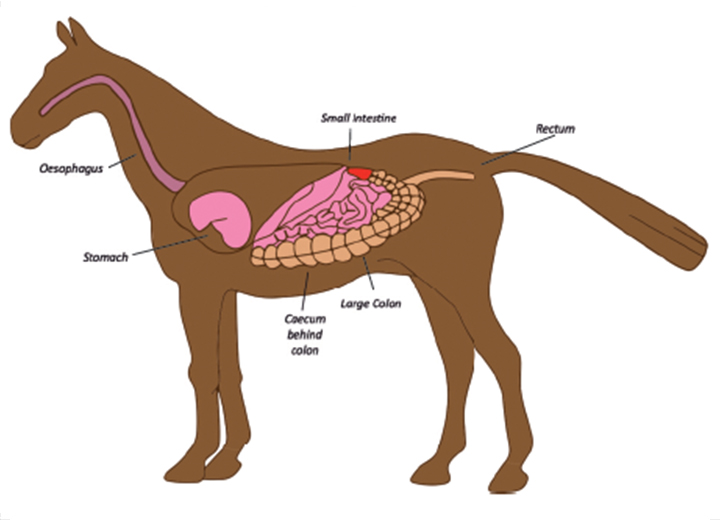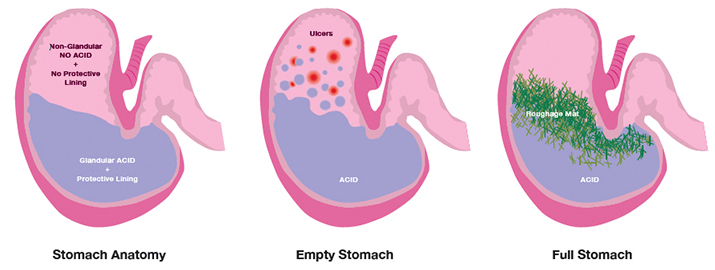



Equine Gastric Ulcer Syndrome (EGUS) is well recognised in all horses, and perhaps particularly in racehorses. Studies consistently show a high prevalence of gastric stress in racing Thoroughbreds, and that incidence only increases in intense training and during periods of active racing. Signs may include a dull coat, an inability to settle and disrupted digestive health. Ultimately the end point of gastric stress in racehorses is lost races and a drop in form, as discomfort in the gut impacts on the horse’s ability to perform to the best of their ability.
Studies show over 90% of racehorses have ulcers.
Trials have shown that feeding a targeted nutritional support to racehorses at risk of EGUS have significant results without any further change to diet or regime.
Antacids
Just as we may reach for an antacid if we had heartburn, so natural antacids can help soothe the equine stomach and maintain a healthy pH. Ingredients such as Calcium carbonate and Sodium bicarbonate are commonly used. Research shows that they can support gastric health, but their benefit is relatively short lived, therefore it is recommended to split between multiple feeds during the day. A gap between offering forage of greater than six hours is also recognised as a risk factor for ulcers. Therefore ensuring antacids are fed regularly in a fibre based feed is recommended.
Probiotics
The complex hind gut microbiota of the horse is well known, and fundamental to digestion and general well being. What is less known is the presence of a microbial population throughout the gut, and the importance of bacterial stability within the stomach to gastric health. Including a live probiotic yeast as a digestibility enhancer supports a stable microbiota throughout the digestive tract.
Antioxidants
Natural antioxidants are recommended to harmlessly flush out toxins which occur as part of any inflammatory response, the influence of which can easily be seen when assessing severity of ulcer score.
Linseed Oil
Including oil in the diet for all racehorses is recommended as it is very energy dense, so effectively increases the energy output of the diet without bulking, but also it has been recognised to be useful in cases of EGUS. It is thought that oil physically protects the delicate stomach lining when added to feed, by coating rough or abrasive feeds, such as chaffs and certain fibres. Much of the research has centred on Linseed Oil (also known as Flax Oil), due to it’s preferential omega 3 to omega 6 fatty acid profile, when compared to other vegetarian oils.
Selected References
Bell RJW, et al: (2007) The prevalence of gastric ulceration in racehorses in New Zealand. NZ Vet J. 2007;55(1):13-8.
Berger S et al (2011) The effect of [GastroForm] on ulcer healing in Standardbred horses in active training. Pferdeheilkunde 27 (2011) 1 (Januar/Februar) 26-30
Murray et al (1996) Factors associated with gastric lesions in thoroughbred racehorses. Equine Veterinary Journal, 1996 Sep;28(5):368-74.
Gastric Health
There are many signs that a horse may have a form of gastric upset, from loose droppings to behavioural changes. The digestive system is a complex process and once it becomes unbalanced, it can lead to ongoing performance limitations.
A brief overview of the Digestive System

The digestive system has many components, starting when food enters the mouth and the teeth grind the food down to smaller, more digestible pieces.
Chewing produces saliva which continues to break down the food and buffers acid right through to the stomach. Once the stomach has emptied - which takes around 30 minutes as it is around the size of a rugby ball - the food is passed into the small intestine. A large proportion of the digestive uptake occurs here, with enzymes working to deliver vital nutrients extracted from the food ration to the bloodstream. After around 1-3 hours the remainder of the ration reaches the hindgut, made up of the caecum and the large colon which can hold around 130 litres - around 13 buckets of water. Bacteria fermentation occurs over a period of around 3 days where those volatile fatty acids that energise our horses and ponies are delivered to the bloodstream.
The stomach and the hindgut are essential digestive elements for daily health function, and stresses on this system can lead to gastric upset and poor health.
The stomach begins breaking down proteins but if too much fermentation occurs here instead of the hindgut, lactic acid is produced and creates gas, which can result in a ruptured stomach lining or gastric colic.
The domestic lifestyle has meant there are now long periods when the stomach lies empty, whether through travelling, ridden work or stabled periods. The result of this lifestyle can have aggressive consequences on the digestive system. The stomach itself has a protected area and an unprotected layer. The squamous area of the stomach (non-glandular) is at risk when the stomach is empty and the continual production of acid destroys the non-protected squamous cells, creating lesions known as squamous ulceration. While the ventral region (glandular) despite being covered in glandular epithelium can be compromised when the individual is prescribed certain medication, resulting once again in acid erosion.
The continual production of acid in the glandular region is topped by a fibrous layer. This is a result of the partly digested forage which sits on top of the acid to reduce splashes onto the non-glandular region, which is unable to cope with the acidic pH.

- Those having a low forage, high concentrate diet
- Limited turnout
- Competition/performance horses
- Inconsistent feeding regimes
- Regular travel
- Increased cereal ration
- Poor appetite
- Weight loss
- Poor performance
- Drop in condition
- Behavioural changes
- Stereotypic behaviour
- Colic
- High fibre diet preferred
- If a dietary change is required, introduce gradually
- Avoid starch and sugar feeds
- Supplementing with proven, quality antacids
Feeding ingredient alone may help but as ever it is the synergy of ingredients that will make a difference, in particular when addressing stomach acid.
An experienced range of antacids will help to buffer the stomach acid that has the potential for harm as well as recognised pre and probiotics to support the stomach’s role in sustaining digestion.
Once a horse has had a form of gastric upset there is a high incidence this will reoccur, feeding to retain digestive balance is vital.
When veterinary treatment has ceased or during veterinary treatment it is important to support with friendly bacterial sources to maintain efficient digestion.
NAF © 2024 | NAF is a trading name of Greencoat Limited, registered in England & Wales. Greencoat Ltd - Registered address: Weston Centre, 10 Grosvenor Street, London, W1K 4QY. Registered Number: 1560 108. Registered in England & Wales.Number: 1560108 VAT Registration Number: 378 9295 80